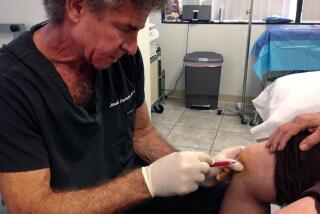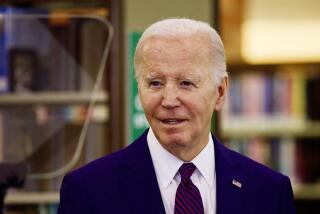Scientists rush to use stem cell funding
- Share via
With the clock ticking, scientists working with human embryonic stem cells were grappling Tuesday with how to use their remaining federal research funds before a court ruling forces them to bring their work to an abrupt end.
Dr. Francis Collins, director of the National Institutes of Health, said scientists can spend the money they have already received to continue their experiments with the stem cells. All of those funds will run out within a year, he said.
The ruling means that some researchers who were counting on an infusion of NIH funds in the next few months are now “in great jeopardy,” Collins said. “This decision has the potential to do serious damage to one of the most promising areas of biomedical research, just at the time when we were gaining momentum.”
A federal judge in Washington imposed an injunction Monday prohibiting federal funding of research involving human embryonic stem cells, after finding that two researchers who are morally opposed to using the cells are likely to win a lawsuit against the Department of Health and Human Services, which runs the NIH.
The researchers contend that a law known as the Dickey-Wicker Amendment precludes the federal government from spending money on any research that involves the destruction of human embryos.
The ruling means that 22 NIH grants worth $54 million for ongoing projects that would have been renewed next month will grind to a sudden halt. The NIH, which funds the bulk of the country’s medical research, has already allocated $131 million for human embryonic stem cell research this fiscal year. That’s the last infusion scientists will receive until there is a legal development in the case.
Scientists said the truncated timetable would prompt them to redirect some of those dollars toward research with less contentious types of stem cells that stand a better chance of winning NIH funds in the future.
At UCLA’s Broad Stem Cell Research Center, Jerome Zack just got his grant renewed Aug. 1. That means he has almost a year left to study how embryonic stem cells grow into blood and immune system cells.
Instead, he is thinking of diverting some of his last $250,000 in federal funds to start new experiments on induced pluripotent stem cells, which behave almost exactly like embryonic stem cells but aren’t made from embryos and are therefore unaffected by Monday’s court ruling.
“It seems like the logical thing to do,” said Zack, who said he counts on NIH money to keep his lab afloat.
But for Dr. Jonathan Garlick at Tufts Medical School in Boston, it’s too late to shift gears: His NIH grant for making gum tissue out of human embryonic stem cells will run out in February, and that’s not enough time for him to finish long-term experiments on animals, no matter how many hours he and his colleagues spend in the lab.
And so Garlick, who is director of Tufts’ Center for Integrated Tissue Engineering, said he would just try to squeeze as much data out of his embryonic stem cells as possible over the next six months.
Similar calculations are being made in nearly 200 laboratories throughout the country.
Some researchers have no choice but to put their plans on hold.
About a dozen grant applications worth more than $15 million were expected to get a green light for funding at an NIH meeting next month but will now be frozen, Collins said.
An additional 50 grants that were awaiting their first round of peer review have been pulled from consideration, he said.
The two researchers who brought the case argued that their ability to secure NIH funding for their work with adult stem cells is hampered because they have to compete with researchers seeking money to work on embryonic stem cells.
But Collins said that this argument made no sense because funding for stem cell projects is not a zero-sum game. All 50,000 applications received by the agency each year are in competition with one another, with no set amount devoted to stem cells.
In the current fiscal year, he noted, the NIH has allocated $137 million for human embryonic stem cell research and significantly more — $388 million — for other types of stem cell research.
One of the plaintiffs in the case, James L. Sherley of the Boston Biomedical Research Institute, got $425,500 of that, according to NIH records.
The Justice Department, which represents the NIH in the case, plans to appeal the injunction and request that it be put on hold, spokeswoman Tracy Schmaler said Tuesday.
Times staff writer Shari Roan in Los Angeles and Ken Dilanian of the Washington bureau contributed to this report.







